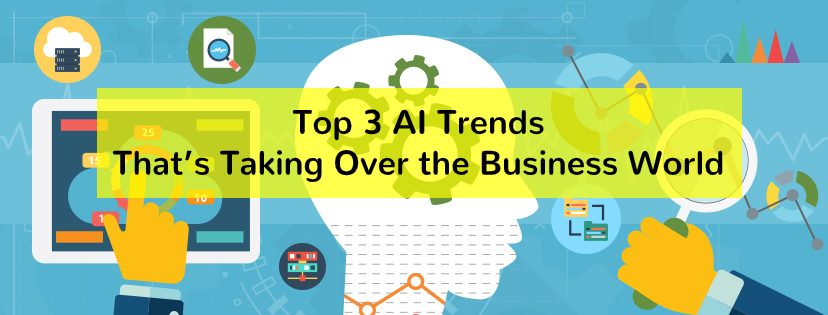Top 3 AI Trends That’s Taking Over the Business World
Businesses across the spectrum are discovering the value that artificial intelligence (AI) can deliver in helping them achieve their goals. Not just a distant idea that provokes ideas of killer robots and job-taking machines, commercially applicable AI is more accessible than ever before.
In fact, 37%of organizations are now implementing AI in one way or another, a number which is only set to grow as the technology develops and businesses realize its commercial potential. That’s why it’s essential to keep our fingers on the pulse of AI’s adoption in various domains. Let’s take a look into the top three trends in AI right now that we can expect to see commercially applied as AI becomes even more popular for growing businesses.
AI in Business Intelligence
Business intelligence (BI) has long been powered by data, but only recently has AI been deployed to help BI experts uncover more accurate insights, faster and more easily than ever before. With AI, companies can quickly break down datasets that previously took them weeks to unravel, and use them to provide tailor-made insights.
For example, by inputting various documents from different sources into a BI dashboard powered by AI, a company could compile all of the information into a data lake and integrate it into whatever other CRM they might be using. This would give them a complete view of all of the previously unstructured data, unveiling insights they had not seen before.
AI can also power BI dashboards with predictive analytics capabilities by learning from past data, enabling them to make more informed decisions and mitigate future problems. These predictive capabilities mean teams can predict the outcome of a certain business decision and act accordingly, without actually having to make it.
Semantic Search
The humble search engine is an integral part of every user’s web experience, from data analysts to the ultimate tech novice. However, for many businesses, a simple keyword search to find what they’re looking for is just not cutting it.
Here’s where semantic search comes in. Semantic search involves using AI and Natural Language Processing (NLP) to truly understand the intent behind the search query and the context in which it has been asked.
And, unlike its keyword-based predecessor, semantic search is able to process data from a whole range of sources, including email, social media, documents, PDF, images, video, and audio. A semantic search engine can pre-process all of this data in its different formats and is then able to stitch them together to respond with the most accurate answers derived from the different sources.
As the value of semantic search becomes more visible, organizations of all sizes will increasingly adopt platforms like that of Microsoft Azureand AWS Comprehendthat enable them to leverage the technology without investing in building it themselves.
AI in Cyber Security
Cybersecurity has been around for decades, yet new potential is now being unleashed with the power of AI. With over 90%of the world’s data created in the last two years alone, and cybercrime losses predicted to reach more than $6 trillionannually by 2021, enhancing the security of our systems and networks is more important than ever.
AI and ML give organizations the power to handle huge volumes of security data and identify potential breaches and threats thanks to various anomaly detectionsolutions. While in the hands of a human analyst, these technologies allow companies to identify incidents such as fraudulent activity and data breaches as soon as they happen.
AI also enhances the Secure Authentication process which many organizations use to make sure people are who they say they are. For example, AI can pick up on anomalies in the way users type or even their spelling error rates and flag these in the system. It can also determine identity through technologies such as biometric scanners, fingerprint checking, and facial recognition.
While it may seem like AI has already taken over many modern businesses, there is still a significant way to go. However, by keeping up to date with the latest trends in commercial AI adoption, organizations can make sure to never miss an opportunity to optimize their processes and expand their capabilities more than they thought possible – all at a cost-benefit that was previously unattainable.





